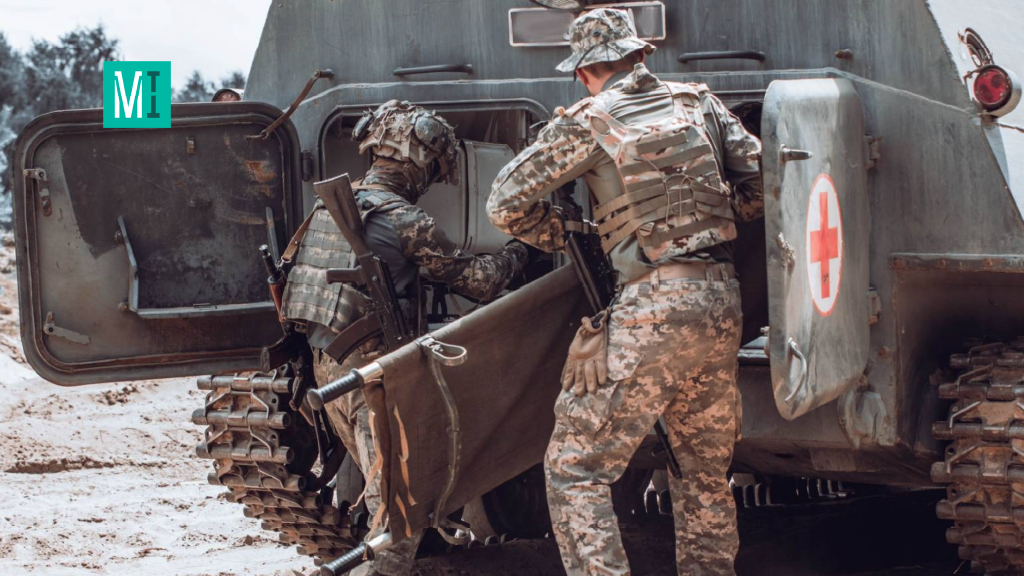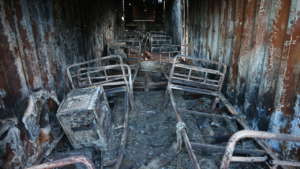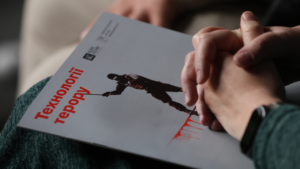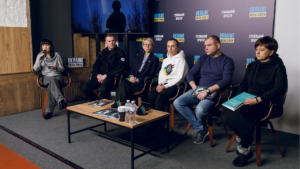Combat Medics of the Armed Forces of Ukraine: How to Save Even More Soldiers

The combat medic occupies a key role in saving lives of the wounded on the battlefield. Such professionals appeared in the Ukrainian army in 2017, but the legal status of combat medics is still debatable. International humanitarian law (IHL) defines them as medical personnel, while most commanders primarily treat them as combatants. Such legal uncertainty prevents freeing combat medics from captivity, because they belong to a protected category in accordance with the Geneva Conventions. This analytical paper aims to provide understanding of why this happens and give recommendations on what to do about this issue.
According to the international humanitarian law (IHL), persons exclusively engaged in provision of medical assistance, that is in the search for, or the collection, transport, diagnosing or treatment (including first aid) of the wounded or sick, are considered to be medical personnel regardless of whether they are members of the armed forces or not (Articles 24 and 28 of Convention (I) for the Amelioration of the Condition of the Wounded and Sick in Armed Forces in the Field (August 12, 1949), Articles 8 and 43 of the Protocol Additional to the Geneva Conventions dated as of June 08, 1977).
Such persons are not recognized as combatants, may not be attacked and held as prisoners of war (except for the need to provide assistance to wounded prisoners).
The provisions about protection of and respect for medical personnel in time of war are a universal right that is recognized by all countries of the world and which they are obliged to respect in all armed conflicts. Violation of these provisions, in particular, a targeted attack on medical personnel, evacuation vehicles, medical institutions, interference with the work of medical personnel, constitutes a grave breach of the laws and customs of war and is a war crime (par. 2 of Article 85, par. 2 of Article 43, Article 8 of the Protocol Additional to the Geneva Conventions dated as of June 08, 1977).
On the other hand, in order for medical personnel to be protected under IHL, they should refrain from directly engaging in hostilities (except in self-defense and protecting the wounded) and must adhere to medical ethics and the neutrality principle. Such personnel are only allowed to carry light weapons, which they can use for self-defense and protection of the wounded.
Medical personnel vs combatants
In line with the NATO standards, two new positions appeared in the Armed Forces of Ukraine in 2017: platoon combat medic and senior combat medic (of a company, battery or similar unit).
According to the current version of the list of positions of the Armed Forces of Ukraine these positions belong to Military Occupational Specialty (MOS) 878, which means junior medical personnel and is specified in Section 9.4. List of MOS – “Medical Specialties”.
New positions were introduced simultaneously with the creation of the Tactical Medicine Training Center as part of the Armed Forces of Ukraine. Here is what the Head of the Center, Lieutenant Colonel Oleh Vozniuk, says about the facility: “Our center runs a combat medic course. Service persons who complete it become platoon combat medics. They will be responsible in their units for providing emergency care, evacuation of the wounded and training of the personnel who serve together with them.
The education and qualification descriptions of a combat medic and senior combat medic were approved for cadets of the Training Center. According to the descriptions these professionals are classified as junior medical personnel without medical education and should possess knowledge and skills, including purely medical components.
At the same time, the order of the Ministry of Defense of Ukraine, which introduces the positions of combat medic and senior combat medic, articulates no principles for using of these specialists in the army.

According to the International Humanitarian Law, combat medics are categorized as medical personnel
Moreover, their status, rights and obligations are not specified by any regulatory document applicable to the Armed Forces of Ukraine in general.
In practice, they are sometimes, but not always, described in orders at the level of brigades and battalions. Sometimes combat medics are assigned the duties typically performed by specialists of other related positions, such as sanitary instructors or tactical medicine instructors, and provided for by the Charter of the Internal Service of the Armed Forces of Ukraine. But even in this case, the list of these duties includes only medical functions: timely identification of patients, provision of medical assistance to military personnel in case of injury (wounds, poisoning), sanitary, hygienic and anti-epidemic measures in a company (battery), etc.
However, in most cases, combat medics do not have clearly defined rights and obligations at all, and they perform their duties based on ad hoc orders of commanders. Also, combat medics do not have appropriate medical certificates.
All this contributes to an erroneous perception of these specialists in the army, primarily by the command. A key discussion revolves around whether to treat combat medics as combatants having specific medical skills or whether they should perform an exclusively medical mission on the battlefield enjoying all privileges and restrictions associated with this status.
First minutes after injury: time not to be wasted
Modern warfare makes it impossible to locate surgical care centers near the forward positions of troops. Under the most favorable conditions, evacuation and delivery of the wounded to the place where they receive surgical care can take from tens of minutes to hours, and days and even weeks in some cases.

As far as tactical medicine is concerned, the first minutes after being wounded usually determine the prospects for survival and recovery of a soldier
In such situation, even if the soldier’s life is saved, the chances of their full recovery and return to duty drop sharply. For example, let us take a serious injury to a limb to which a tourniquet has been applied to stop bleeding. If the tourniquet is used for more than six hours, the probability of limb amputation is almost one hundred percent. After this, the service person is likely to be transferred to the reserve, the Ukrainian army will lose a soldier, and the government will be obliged to support him for life.
But it is a different story when the wounded are treated professionally and timely. Then they will most likely recover and return to duty. However, there must be someone who will provide such assistance. And this is a combat medic.
As far as tactical medicine is concerned, the first minutes after being wounded usually determine the prospects for survival and recovery of a soldier.
If within this time period care is provided at a high professional and quality level, the probability of survival increases and the duration of injury-related disability is reduced.
In order to provide assistance at this level, it is not sufficient to organize general military training in tactical medicine, as it does not include practicing, for example, in removing or replacing a tourniquet with safer means of controlling bleeding. However, combat medics have such skills. And when they are involved on the battlefield for medical purposes, it has a direct impact on the number of lives saved.
Combat or field medic
International humanitarian law guarantees a high level of protection for medical personnel whose key function is to search, rescue and evacuate the wounded. At the same time, we have a situation where the status of a combat medic is not determined in the publicly available rules and regulations of the Armed Forces.
Because of this, such professionals are often used inefficiently, assigning them the responsibilities of combatants and thereby wasting resources invested in their training as medical personnel and reducing the potential to save the lives and health of soldiers. But the most important problem is that if commanders use combat medics as combatants, they are no longer under IHL protection.
We believe that one of the reasons behind this approach lies in the name of the combat medic post itself. Perhaps commanders on the front line, who are primarily focused on the task of holding or occupying positions, consider the first word – combat – to be a key word in the phrase combat medic. In such a case, replacing it with, say, “field” would make it possible to get rid of the formal sign of a combatant for such service persons.
There is another reason why determining the legal status of a combat medic is important. In the conditions of an armed conflict, the time of professional training of service persons was reduced to 1 month. This is enough to ensure high-quality professional training, however, consolidation of knowledge requires practice and constant improvement of skills in tactical medicine. Therefore, the combat medic is faced with the dilemma about whether to enhance professional medical or combat skills. If such person will act as a combatant, that is, without special IHL protection, and will be used by the commander in the same manner as other combatants, their priority will most likely be polishing combat skills rather than acquiring in-depth medical knowledge and experience. As a result, the quality of pre-hospital care may be negatively affected, which will increase the number of casualties and those who will not return to the army after being wounded.
Protection from captivity and punishment for crimes against medical personnel
The official status of a combat (field) medic as a member of medical personnel is unlikely to safeguard such service person from an enemy attack during combat. Instead, in a situation where they come under enemy control and have a Geneva Convention I.D. Card, special protection is automatically afforded them. Holding such service persons in captivity is prohibited by international law.
At present, Russia and its armed forces do not comply with IHL. They attack Ukrainian medical personnel and hold them captive. However, the process of documenting and investigating war crimes continues, and the time will come when war criminals will be brought to justice, particularly for crimes against medical personnel. And then the lack of an official status of a combat medic in Ukraine will make it difficult or even impossible to bring criminals to justice, because if a medic is engaged as a combatant, this allows the opposing side to keep such medic in captivity until the end of hostilities.
In addition, even now there are combat medics held by the enemy in captivity who, quite likely, performed purely medical functions on the battlefield. The success in using international legal mechanisms for releasing these persons, in particular through UN bodies, depends largely on how Ukraine defines functions and status of combat medics.
Conclusions and recommendations
- We must admit that the concept of using combat medics in the Armed Forces of Ukraine has not been formalized. However, there is de facto an established practice of not functionally separating combat medics from combatants.
- In our opinion, the practice of using combat medics as combatants goes against the spirit of IHL and the interests of the state, which lie not only in maintaining the combat capability of military personnel, but also in returning of the wounded to an ordinary civilian life.
- This can result in that a service person, faced with tasks typical for combatants and realizing the lack of special legal protection, will not be interested in acquiring a high level of qualification as a combat medic. Their priority may be general military training, handling weapons and ammunition, rather than searching for, helping and evacuating the wounded. That is, the medical component of a combat medic profession will fade into the background.
- We believe that there is no significant increase in the combat capability of the army due to the involvement of combat medics as additional fighters. Instead, the use of combat medics as combatants reduces the tendency to improve the quality of pre-hospital care for the wounded.
- We are convinced that in terms of IHL and strategic interests of the state, a combat medic should be treated as a member of medical personnel. Such specialist should focus on tactical medicine, complete high-quality professional training, know how to administer medicines, use complex equipment necessary to save the military, and be aimed at returning as many wounded soldiers as possible to duty.
- For this purpose, the Ministry of Defense of Ukraine and the command of the Armed Forces of Ukraine, in our opinion, should develop and implement conceptual framework for the role of combat medics in the army, specify their rights and obligations, issue them medical personnel certificates in accordance with IHL, and make every effort to improve the qualification level of combat medics.
Vladyslav Rudenko, Partner in the Umbrella Law Firm, instructor at the Tactical Medicine Training Center of the Armed Forces of Ukraine
Andrii Yakovliev, Managing Partner in the Umbrella Law Firm, MIHR expert
Stanislav Miroshnychenko, Head of the Information Department of the MIHR








